How Magnets Work
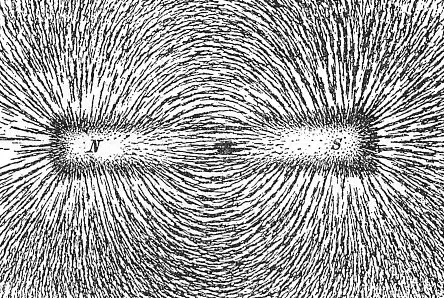
Source: https://commons.wikimedia.org/wiki/File:Magnet0873.png. Author: Newton Henry Black (1913)
Everyone has observed magnetism, from refrigerator magnets to playing with hobby magnets, and more. Magnetism is a fundamental force of nature. Magnets are a direct result of the physics taking place at the atomic level (i.e. quantum level) within the material of the magnet. Magnetic fields are polarized with two magnetic poles called North and South. One of the interesting features of a magnet is that, if you break it into smaller pieces, it will still have magnetic north and south poles. Even if you break a magnet into fragments down to the size of individual atoms, those fragments will still have a magnetic north and south pole. The figure below illustrates this.
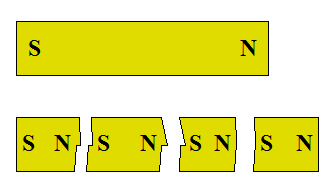
Inside permanent magnets, the magnetism is produced by the electrons inside the material. Electrons have an intrinsic magnetic field around them. In permanent magnets, the magnetic fields of the electrons add together to produce a net magnetic field surrounding the magnet. In non-magnetic materials, the magnetic fields of the electrons cancel out, producing no net magnetic field surrounding the material.
Magnetism is an invisible force of nature, like gravity. A magnet can, like gravity, attract another object toward itself, but it can also repel an object away from itself, provided that the other object is also a magnet. For example, placing both north or south ends of two magnets in close proximity to each other will cause the magnets to repel. Placing the north and south ends of two magnets in close proximity to each other will cause the magnets to attract. In other words, opposite poles attract, and like poles repel. The figure below illustrates this.
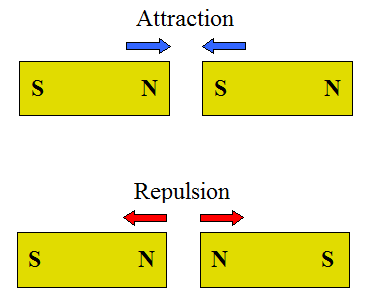
Magnetic field lines are a convenient mathematical representation which allows us to visualize how the magnetic field is distributed around a magnetic object. Magnetic field lines denote the direction of the magnetic force at any point in space. There are an infinite number of magnetic field lines. For convenience we usually only draw a few of these lines to give a visual idea of the shape of a magnetic field. Iron filings, due to their small size, are a great way to visualize magnetic field lines. A magnetic field is a vector field giving the direction of the magnetic forces anywhere inside the field, which in theory extends to infinity, although beyond some distance from a magnet the magnetic force becomes vanishingly small. The convention for magnetic field lines is that they originate from the magnetic north pole and enter the magnetic south pole. The figure below illustrates the magnetic field lines surrounding a bar magnet.
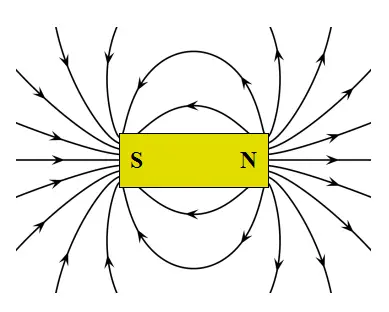
A small magnetic object placed inside the magnetic field will align itself with the magnetic field lines such that the magnetic north pole of the object points along the field line towards the magnetic south pole of the magnet. Similarly, the magnetic south pole of the object points along the field line towards the magnetic north pole of the magnet.
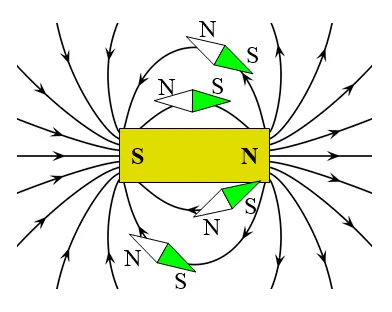
The picture at the top of the page shows the magnetic field of a bar magnet using iron filings. A sheet of paper is laid on top of a bar magnet and iron filings are sprinkled on the paper. The iron filings immediately align themselves with the magnetic field. The needle shaped filings align with their long (north-south) axis parallel to the magnetic field, and show the direction of the magnetic field lines at each point.
A piece of iron can be picked up with a magnet, even if it is originally non-magnetic. When the iron is placed near a magnet its magnetic domains (consisting of billions of magnetically aligned atoms) become aligned causing the material itself to become magnetic (with a north and south pole). It can then be picked up by the magnet. This piece of iron can then also attract other pieces of iron for example (including other magnets). When the magnet is removed the magnetic domains of the material sometimes return to their previous random orientation and the material stops being magnetic. The picture below shows a magnet picking up a coin which makes the coin magnetic which then enables it to pick up two other coins. This is an example of ferromagnetism.
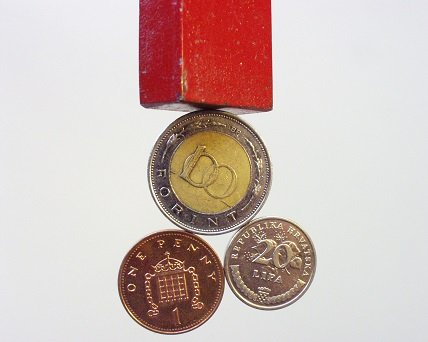
Source: https://commons.wikimedia.org/wiki/File:Ferromagneses_penzermek_1.jpg. Author: https://commons.wikimedia.org/wiki/User:Fizped
Ferromagnetism is the strongest form of magnetism occurring in materials. The elements iron, cobalt, nickel, gadolinium, dysprosium, and alloys containing these elements exhibit ferromagnetism due to a phenomenon related to their electron spin called "exchange coupling", in which the electron spin of one atom interacts with the electron spin of neighboring atoms. This results in magnetic alignment of the atoms (giving rise to magnetic domains). Note that electron "spin" is a fundamental property of electrons that gives rise to their magnetism. The presence of exchange coupling in ferromagnetic materials enables them to produce the most powerful magnetism; much more powerful than the other two main types of magnetism, which are diamagnetism and paramagnetism. In diamagnetic materials, an externally applied magnetic field causes an induced magnetic field to develop in the material which repels the external magnetic field. Thus, diamagnetic objects experience a force that "pushes" them away from external magnetic fields. In paramagnetic materials, an externally applied magnetic field causes an induced magnetic field to develop in the material which attracts the external magnetic field. Thus, paramagnetic objects experience a force that "pulls" them towards external magnetic fields. Diamagnetic and paramagnetic effects are caused by quantum-mechanical effects (just like ferromagnetism) but are very weak compared to ferromagnetism. However, with a strong enough external magnetic field diamagnetic and paramagnetic objects can be repelled and attracted, respectively. For example, a frog (and all other animals) is diamagnetic and can be levitated in the presence of a strong enough magnetic field.
You can make a permanent magnet by subjecting a magnetizing material (such as iron) to a strong enough external magnetic field. This causes the magnetic domains to align and "lock" in place. When the external magnetic field is removed the domains will remain in their aligned positions and the material will be permanently magnetized.
You can also make a magnet by passing an electric current through a wire coil. This creates a magnetic field, according to Ampere's law. This is called an electromagnet and is used in junkyards to pick up large amounts of steel scrap.
The earth is a large magnet, and since opposite poles attract in magnets, the north pole of a magnetic compass needle points towards the south pole of the earth's magnetic field (located in the geographic north), and the south pole of the compass needle points towards the north pole of the earth's magnetic field (located in the geographic south). The magnetic field of the earth is believed to be produced by the convecting and circulating motion of the molten iron interior of the earth.
Return to Physics Essays page
Return to Real World Physics Problems home page
Free Newsletter
Subscribe to my free newsletter below. In it I explore physics ideas that seem like science fiction but could become reality in the distant future. I develop these ideas with the help of AI. I will send it out a few times a month.